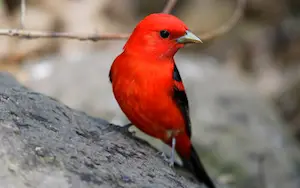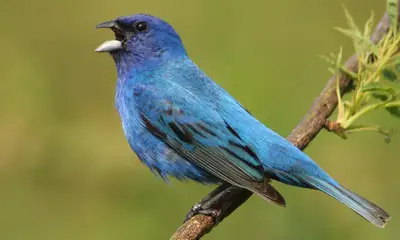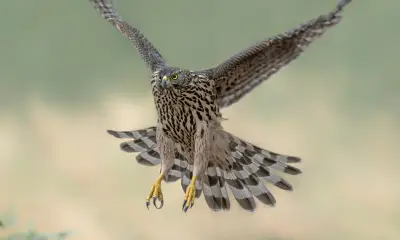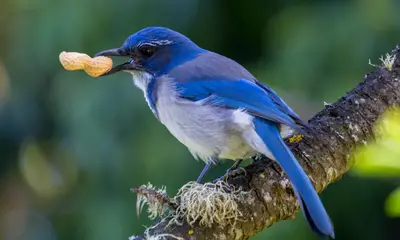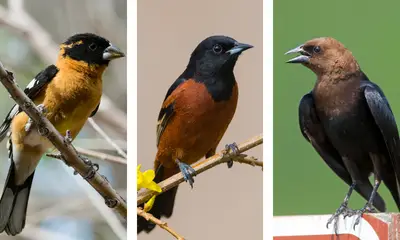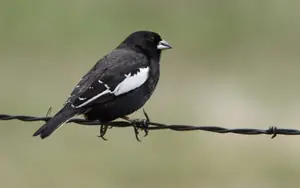13 Types Of RED BIRDS In California (ID Guide With Photos)
Did you recently come across a red bird in California, and want to know what species it was?
Identifying red-colored birds in California is not as easy as it might seem, since there are many bird species in the Golden State that are either completely red or partially red.
To help you identify the bird you saw, we’ll cover all the different red birds of California.
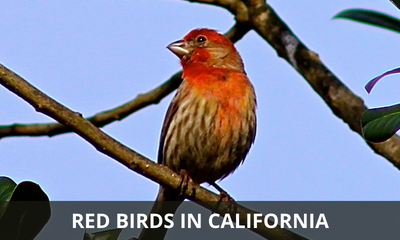
What red birds are found in California?
The 13 types of red birds found in California are:
- House Finch
- Summer Tanager
- Vermilion Flycatcher
- Hepatic Tanager
- Western Tanager
- Cassin’s Finch
- Purple Finch
- Pine Grosbeak
- Red Crossbill
- Northern Cardinal
- White-winged Crossbill
- Red-breasted Sapsucker
- Red-naped Sapsucker
Two of these California birds are entirely red (the Northern Cardinal and Summer Tanager), while the others are partially red (more on that below).
Now let’s dive into the details, and take a closer look at each of these birds in order to get the full scoop:
House Finch
Scientific name: Haemorhous mexicanus
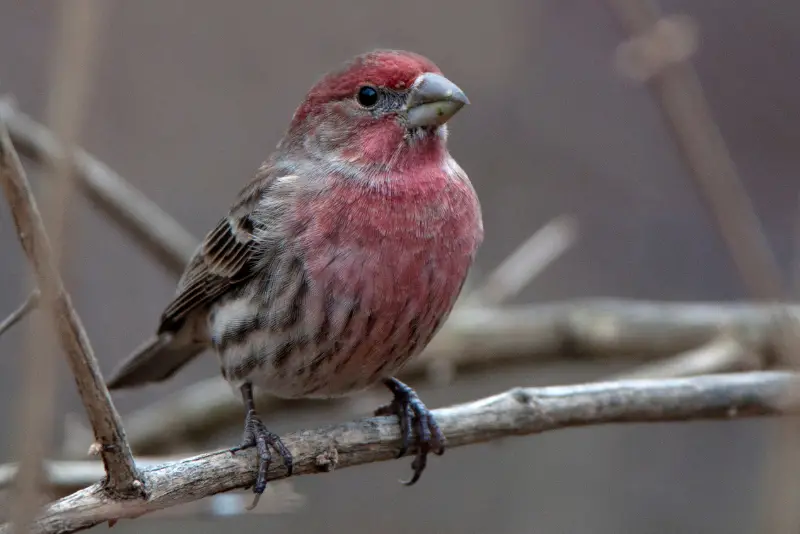
The House Finch is a common red bird in California, and is mostly found in settled areas, ranging from small towns to large metropolitan centers.
Adult male House Finches can be identified by the bright red feathers on the head and upper breast, although in some cases they are slightly more orange or yellowish in color.
The females lack any red coloration, and instead have grayish streaks on a brown background.
The House Finch was originally a western bird, and it wasn’t until the 1940s that this bird was discovered in New York and other places on the east coast of the US.
These finches are the most common red birds found in California
The eastern House Finch population began to grow in the 1950s and 60s, and by the year 2000, it had expanded so far west that it connected with the original western population.
The House Finch is entirely herbivorous, and feeds on seeds, buds, and fruits.
If you set up a bird feeder in your backyard, you can expect House Finches to be among the first birds to visit it.
The House Finch is found in California all year round, and while it is not a migratory bird, it does move around to find areas with more food outside of the breeding season.
Summer Tanager
Scientific name: Piranga rubra
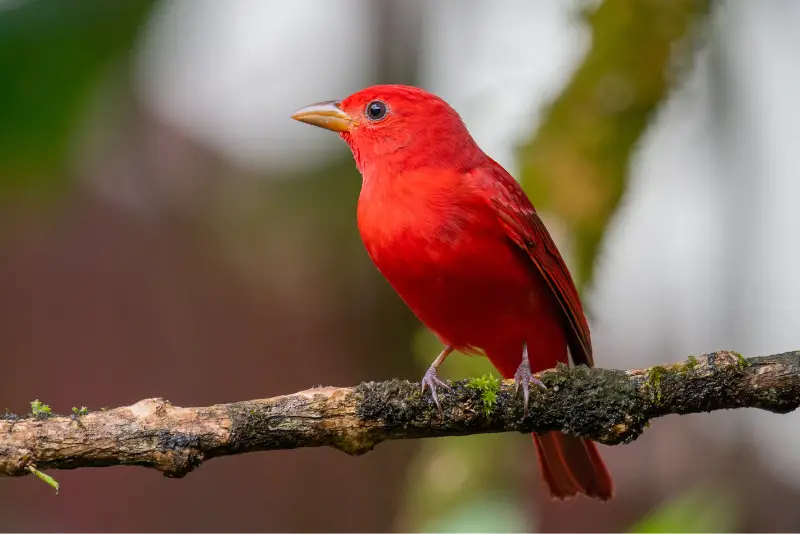
The Summer Tanager is a beautiful and alluring songbird with a peaked (as opposed to rounded) crown.
Adult male Summer Tanagers are entirely bright red, although they have slightly darker feathers on their wings.
It can be hard to observe Summer Tanagers, since they like to forage high in the treetops of deciduous and mixed forests, where they feed on insects, including bees and wasps.
In contrast to males, females and immature are more inconspicuous, and look more like buff yellow California birds, although they sometimes have a few patches of pale red.
The Summer Tanager is a summer visitor and breeding bird in southern California, where it can be seen from May through August.
It is a strict migratory bird and spends the rest of its year in Central and South America
Vermilion Flycatcher
Scientific name: Pyrocephalus obscurus
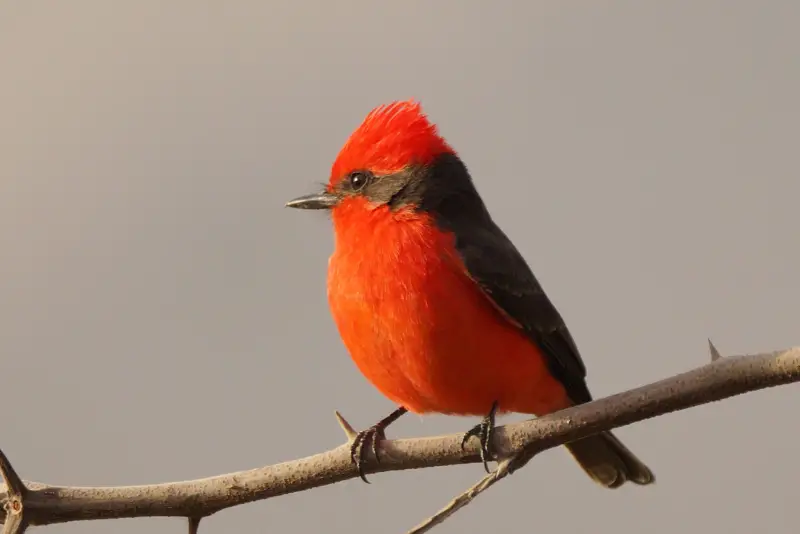
The Vermilion Flycatcher is one of the most beautiful birds that can be seen in California, and is found as a winter bird in open landscapes of southern California.
Adult males have a scarlet red underside, throat, and crown, while the rest of their body is dark brown.
Females and immature birds, on the other hand, are grayish brown on top, and pale underparts.
It is a strict migratory bird, and the Vermilion Flycatchers that can be seen in California are winter visitors that breed in Nevada and Arizona.
A great thing about this bird is that it isn’t very shy towards, and usually can be easily observed on exposed perches.
The preferred habitat of the Vermillion Flycatcher is open woodland and parks in areas close to water.
Hepatic Tanager
Scientific name: Piranga flava

The Hepatic Tanager is a brightly colored songbird that resembles the Summer Tanager.
Adult males are mostly red, with gray undertones behind their eyes and on their back, and this gray coloration distinguishes them from males of the Summer Tanager.
Females, immature males, and juveniles, on the other hand, are more yellow with a grayish color on their ear coverts and back.
If you’re lucky, you might be able to glimpse them in southern California from May through August. They spend the remainder of the year in Mexico or Central America.
And although these birds are not particularly shy, their colors mix in so perfectly with the foliage that they can be difficult to spot.
Western Tanager
Scientific name: Piranga ludoviciana
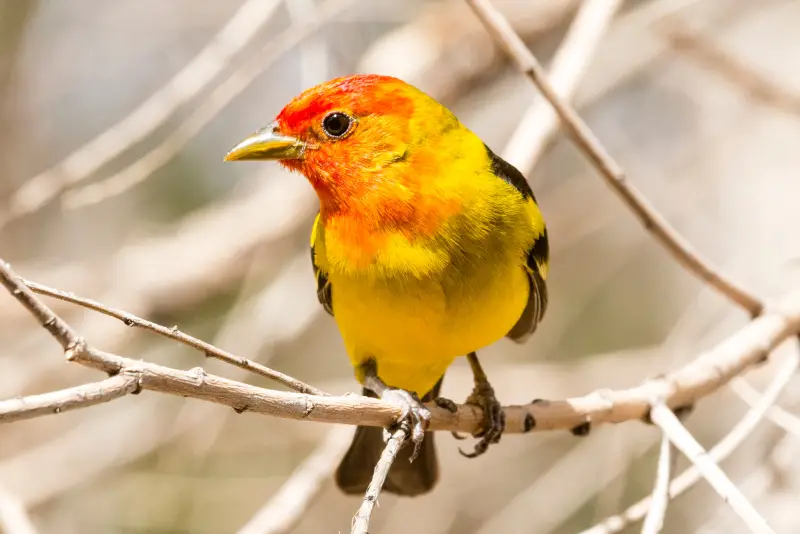
With its brilliant hues, male Western Tanagers are difficult to overlook.
Adult males have a black back, tail, and wings in the summer, with two yellow and white wingbars. Their bodies are yellow, while their head and throat are orange-red.
Females and juvenile birds have a similar appearance, but the yellow is duller and the red color is almost absent, with the exception of a speck near the base of the beak.
The Western Tanager may be seen in northern California during the breeding season from May to August. These exotically colored birds spend the remainder of the year in Central America.
Cassin’s Finch
Scientific name: Haemorhous cassinii
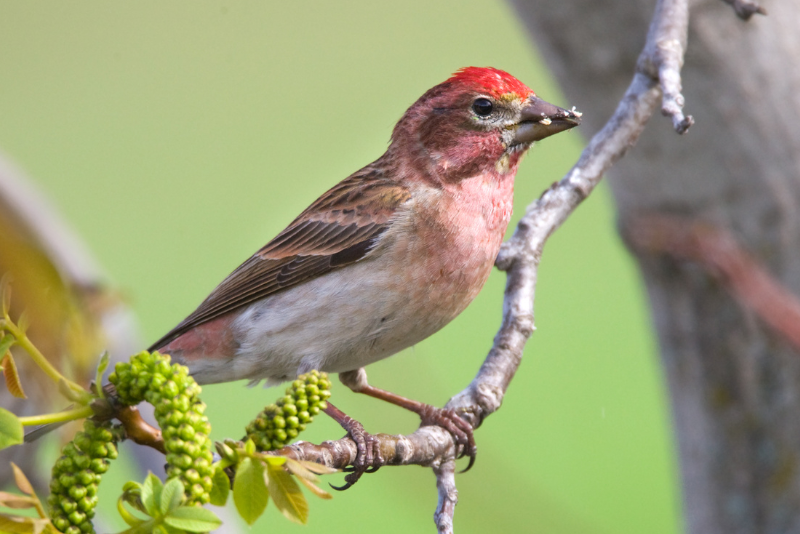
The Cassin’s Finch looks a lot like the Purple Finch, but is mostly found at higher altitudes than the latter.
Adult males have a raspberry red crown, chest, throat, and rump. Their neck and back are streaked brown, and their wings are somewhat darker with two pink wingbars and pale margins.
Adult females and juveniles lack the reddish color and instead are brown with dark streaks on top and slightly darker wings with two pale wingbars.
The Cassin’s Finch prefers coniferous forests and can be seen all year in mountainous habitats of northern California.
Outside of the breeding season, it forms flocks and sometimes visits lower elevations and more southern latitudes, especially in cold winters.
Purple Finch
Scientific name: Haemorhous purpureus

The Purple Finch is a little songbird with a compact body, a conical beak, and a head that is disproportionately larger than its body.
The heads and breasts of adult males are a deep shade of raspberry red, while the backs of their bodies are streaked with red and brown. The flanks are cream colored with pink streaks.
Birds from the eastern part of the range have a white belly, whereas birds from the western part of the range have a gray belly. Purple Finches in California have a gray belly.
The upperparts of females and immature birds are streaked with a grayish brown, while the underparts are a light cream color with brown streaks.
The Purple Finch is a breeding bird and year-round resident in northern California, and also occurs further south in the state during the winter months.
Red Crossbill
Scientific name: Loxia curvirostra
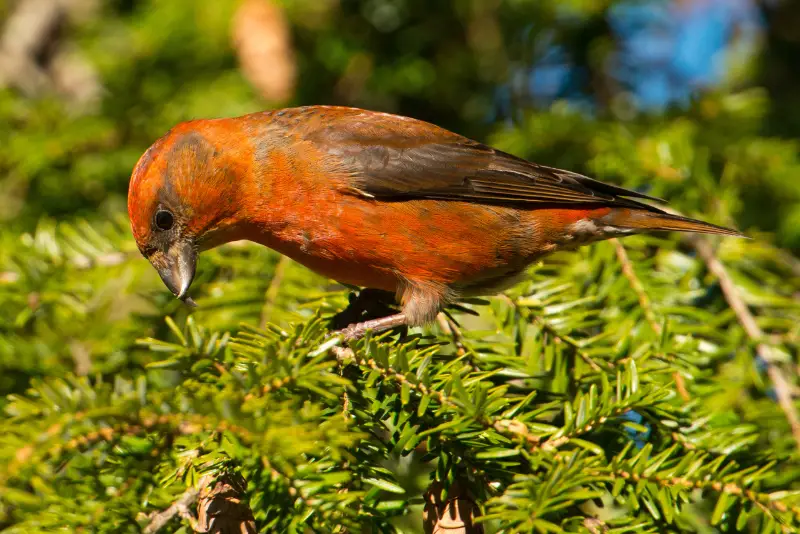
These birds get their name from their distinctive bills, which resemble a bent pair of scissors with their points crossed.
Adult males of this red bird have a deep red head, underside, and rump, while their wings and back are dark brown
Females and immature Red Crossbills are more inconspicuous, and are olive-colored with reddish streaks on their flanks and belly.
Red crossbills are able to harvest seeds from pine cones by cutting through the scales of the cones with their crossbill.
They will use their feet to keep the cones pinned down while they use their tongues to pick the seeds out of the cones and then eat them.
This red bird is most commonly found breeding in Canada and northern parts of the USA, but also has a breeding population in northern California, as well as being a scarce winter visitor in more southern parts of the state.
The breeding season of these crossbills is timed to coincide with ripening of pine or spruce cones, and can sometimes start as early as February.
Pine Grosbeak
Scientific name: Pinicola enucleator

The Pine Grosbeak is a raspberry red songbird with a short and stubby bill.
Adult males are red with varying amounts of gray on their sides and bellies. The tail and the wings are dark with two white wing bars.
Females are more drab, and have a more brownish yellow coloration compared to the males.
The Pine Grosbeak in California belongs to the subspecies Pinicola enucleator californica (which was first described by William Price in 1896).
These red birds are found in the Sierra Nevada mountains of Central California, where they are year-round residents.
During the cold season, there is an influx of northern Pine Grosbeaks that spend the winter in the Golden state.
Northern Cardinal
Scientific name: Cardinalis cardinalis
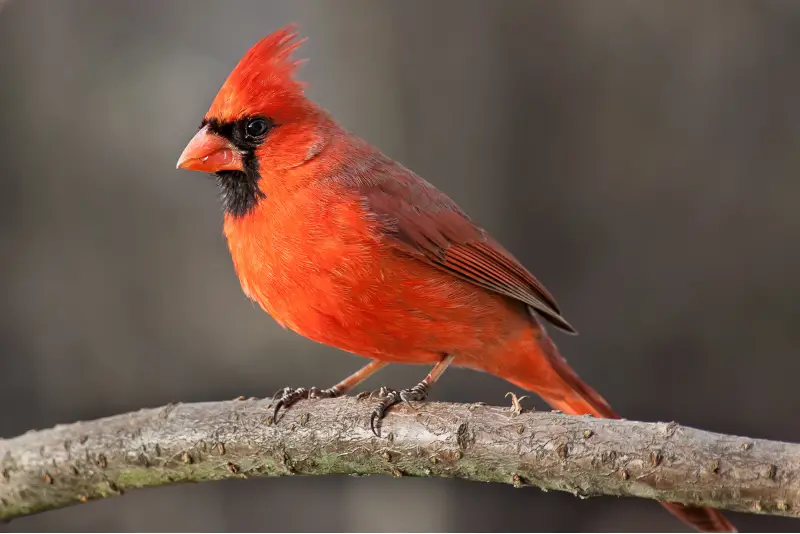
While the Northern Cardinal is one of the most well known red birds in North America, it is a rare species in California.
Male Northern Cardinals have a bright crimson red color almost all over, with a slightly darker red on their back and wing feathers.
In addition, the face has a black mask extending from the bright red bill to the throat.
Female Northern Cardinals are not quite as colorful as males, and have a more buff-brown body color with some reddish tinges, although they also have a bright red bill.
There is a small population of Northern Cardinals in Los Angeles, where they were introduced at the end of the 1800s. In this area it is a rare resident in backyards, small forests, and parks.
During the winter months it doesn’t defend its territory, and sometimes gathers in flocks of many individuals that feed together.
White-winged Crossbill (Two-barred Crossbill)
Scientific name: Loxia leucoptera
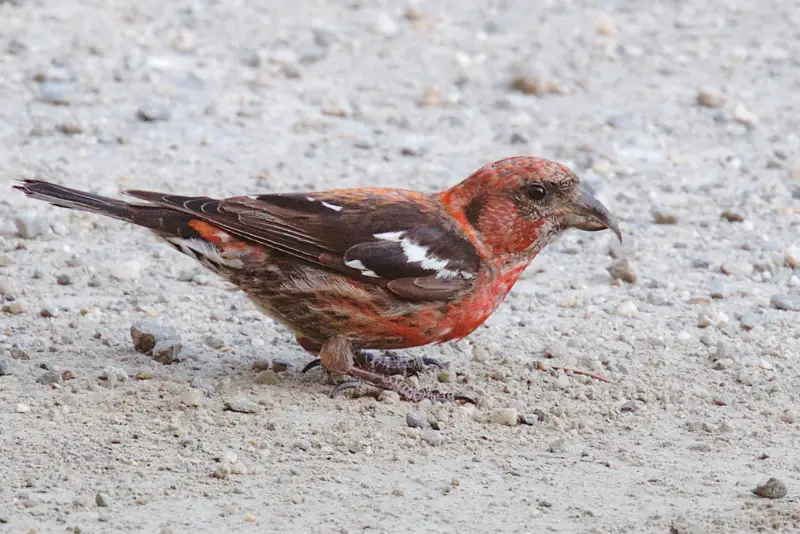
Similar to other crossbills, the White-winged Crossbill has a cross-tipped beak.
Most of the body plumage of adult male White-winged Crossbills is pinkish red, although it is paler compared to the color of Red Crossbill males.
The black wings have two white wing bars that are prominently visible (explaining the name of this crossbill).
The body of females is streaked with a yellowish color, but their wings are black with a wingbar pattern similar to that of males.
White-winged Crossbills are largely non-migratory, and remain in the breeding range in Canada and northern and western states of the US all year round.
In California, White-winged Crossbills are seen as scarce winter vagrants that are more abundant in some years.
Red-breasted Sapsucker
Scientific name: Sphyrapicus ruber
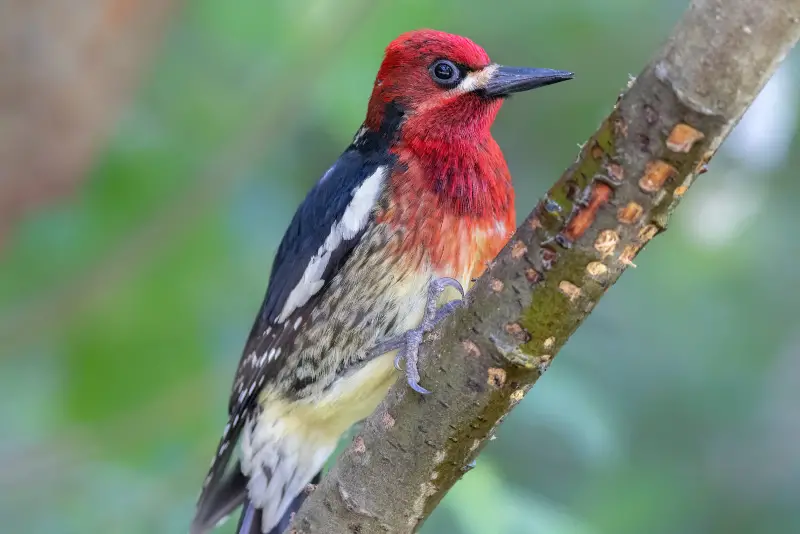
The Red-breasted Sapsucker is a striking member of the woodpecker family, due to the scarlet red head and breast of adult birds.
The back is dark brownish green, while the belly is cream colored with dark spots and streaks. Juvenile birds look similar, but lack most of the red coloration.
Red-breasted Sapsuckers are birds of westernmost North America, and occur in a band along the coast from southern California all the way up to southern Alaska.
They are regular breeding birds in mixed forests of northern and southern California, and can be seen in the rest of the state during winter, when there is an influx of northern sapsuckers that migrate to California for the winter.
Red-naped Sapsucker
Scientific name: Sphyrapicus nuchalis
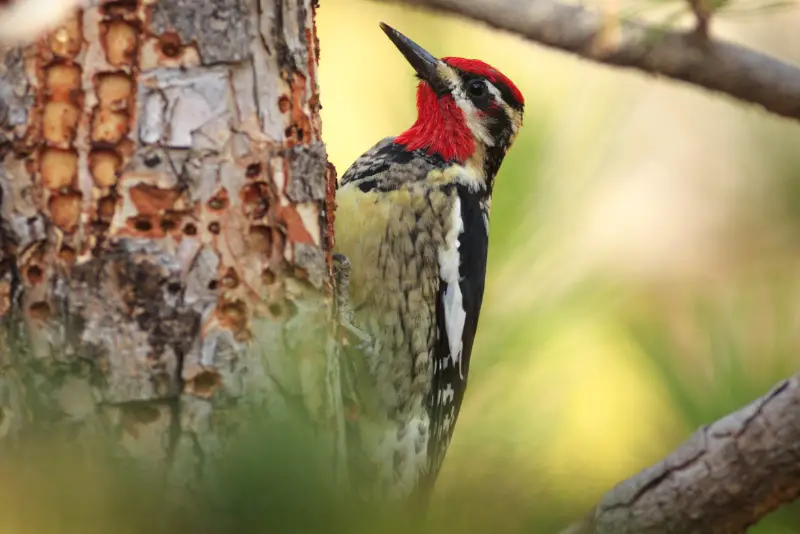
The Red-naped Sapsucker is another woodpecker species with striking red coloration on the head. Adult birds have a bright red nape plus a red throat.
The partially red coloration on their head makes it easy to tell them apart from Red-breasted Sapsuckers, which have completely red colored heads.
While the Red-naped Sapsucker is a rare breeding bird in the Sierra Nevada Mountains of California, it is more common during the winter months, when it can be seen wintering throughout southern California.
What California birds are black and red?
There are four types of black and red birds in California:
- Summer Tanager
- Vermilion Flycatcher
- Northern Cardinal
- Red-winged Blackbird
Red-winged Blackbirds are the most common red and black birds found in California. Males are almost entirely black, but have a patch of bright red on their shoulders.
In contrast, male Northern Cardinals (which are very rare in California) are almost entirely red, except for a black face.
What are the small red birds in California?
Small red-colored birds found in California are most often House Finches, which are common birds in California. Males can be readily identified by their reddish head, upper chest, and back
However, during the winter you can also encounter other small birds in California that are red: the Purple Finch and the Cassin’s Finch.
Both of these are breeding birds in the northern parts of California, while they also occur as winter birds in southern parts of the state.
How to attract birds to your yard in California
The top 5 things you can do to attract red birds to your yard are as follows:
- Set up a feeder with sunflower seeds or a seed mix
- Set up a bird bath
- Plant shrubs to provide nesting opportunities
- Plant native fruiting plants
- In order to attract fruit-eating birds, offer apples or berries at your feeder
Observing birds at a bird feeder can be one of the most fun ways to practice bird watching from the comfort of your own home.
Final remarks
This concludes our article on the types of red songbirds found in California.
If you’ve spotted one of these red birds while bird watching in your backyard, hopefully this ID guide will help you identify it quickly and easily.
And if you enjoyed this article, check out our guide to the large birds of California.

